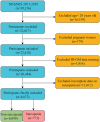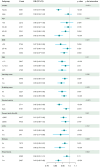The dietary inflammation index and body mass index mediate the association between the dietary index for gut microbiota and sarcopenia in older women: evidence from NHANES 2011-2018
- PMID: 40901292
- PMCID: PMC12399385
- DOI: 10.3389/fnut.2025.1624844
The dietary inflammation index and body mass index mediate the association between the dietary index for gut microbiota and sarcopenia in older women: evidence from NHANES 2011-2018
Abstract
Background: The dietary index of gut microbiota (DI-GM) was developed to assess dietary quality by reflecting the diversity of the gut microbiota composition. This study examined the relationship between DI-GM and sarcopenia risk and evaluated the potential moderating effects of diet-related factors on sarcopenia risk in adult individuals.
Methods: This cross-sectional study included 8,872 adults from the National Health and Nutrition Examination Survey (NHANES) database between 2011 and 2018. Weighted multivariable logistic regression, restricted cubic splines (RCS), and subgroup analyses were used to investigate the association between DI-GM and sarcopenia. Mediation analysis was employed to examine the impact of the dietary inflammatory index (DII), systemic immune-inflammatory index (SII), and body mass index (BMI) on the relationship between DI-GM and sarcopenia.
Results: Among the eligible participants, 773 (8.71%) had sarcopenia. The mean DI-GM value was significantly lower in the sarcopenia group than in the non-sarcopenia group (4.76 vs. 4.99, p < 0.001). Multivariable logistic regression analysis revealed a negative association between DI-GM and the risk of sarcopenia, irrespective of whether the independent variable was analyzed as a continuous variable or in quartiles in the fully adjusted model (Model 3, continuous variable: OR = 0.91, 95% confidence interval (CI): 0.88-0.95, p < 0.001; Q4 vs. Q1: OR = 0.67, 95% CI = 0.56-0.80, p < 0.001, p for trend<0.001). The RCS curves illustrated a non-linear relationship between DI-GM and sarcopenia risk. Subgroup analyses indicated an inverse relationship between DI-GM and sarcopenia risk across various covariates in the study. Mediation analysis demonstrated that 46.32, 2.29, and 29.63% of the association between DI-GM and sarcopenia was mediated by the DII, SII, and BMI, respectively.
Conclusion: A lower DI-GM score was strongly associated with an increased risk of sarcopenia, particularly among older adults, women, individuals with hypertension, and individuals with reduced physical activity. The DII and BMI may mediate the relationship between DI-GM and sarcopenia risk, suggesting that a diet promoting gut health could be an effective strategy for preventing sarcopenia. Additional longitudinal or interventional studies are required to substantiate the findings of this study.
Keywords: DI-GM; NHANES; dysbiosis; gut microbiota; sarcopenia.
Copyright © 2025 Zhang, Wu, He, Zhang and Hua.
Conflict of interest statement
The authors declare that the research was conducted in the absence of any commercial or financial relationships that could be construed as a potential conflict of interest.
Figures




References
LinkOut - more resources
Full Text Sources

